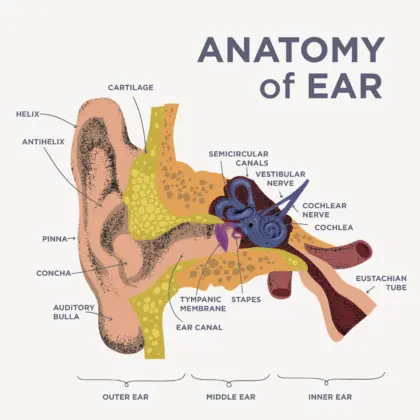The ear explained

Understanding the Anatomy of the Ear
The ear is much more than just the part you can see on the outside — it’s a complex and fascinating organ that helps us hear the world around us and keep our balance. Let’s take a closer look at the three main parts of the ear and how they work together.
Outer Ear: Catching the Sound
The outer ear is like nature’s built-in sound collector. The part you see on the side of your head is called the pinna (or auricle). It’s shaped to catch sound waves from the environment and funnel them into the ear canal, a narrow passageway that leads deeper into the ear. The ear canal channels sound waves all the way to the eardrum — a thin, flexible membrane that marks the start of the middle ear.
Middle Ear: Turning Vibrations into Signals
When sound waves hit the eardrum, it vibrates — kind of like a drum being tapped. These vibrations need a little help to reach the inner ear, and that’s where three tiny bones called the ossicles come in. These bones are the smallest in the human body and have special names: the malleus (hammer), incus (anvil), and stapes (stirrup). They work together to amplify the vibrations and pass them on to the next part of the ear. The middle ear also connects to the throat via the Eustachian tube, which helps balance air pressure on both sides of the eardrum so you can hear properly.
Inner Ear: Decoding Sound and Balance
The inner ear is where the magic really happens. It contains the cochlea, a spiral-shaped, fluid-filled tube that converts those vibrations into electrical signals your brain can understand as sound. Inside the cochlea are tiny hair cells that move in response to the fluid’s motion — this movement triggers nerve impulses sent through the auditory nerve to your brain.
But the inner ear isn’t just about hearing. It also houses the vestibular system, which keeps you balanced and aware of your body’s position. This system includes three semicircular canals and two small sacs called the utricle and saccule. They detect head movements and help you stay steady whether you’re standing still, walking, or spinning around.
The ear’s design is truly remarkable — from capturing sound waves to helping you keep your balance, it’s a finely tuned system working around the clock so you can experience the world in all its richness.
Book a FREE Hearing health check
📞 0800 054 8458
🖥️ Book Online
